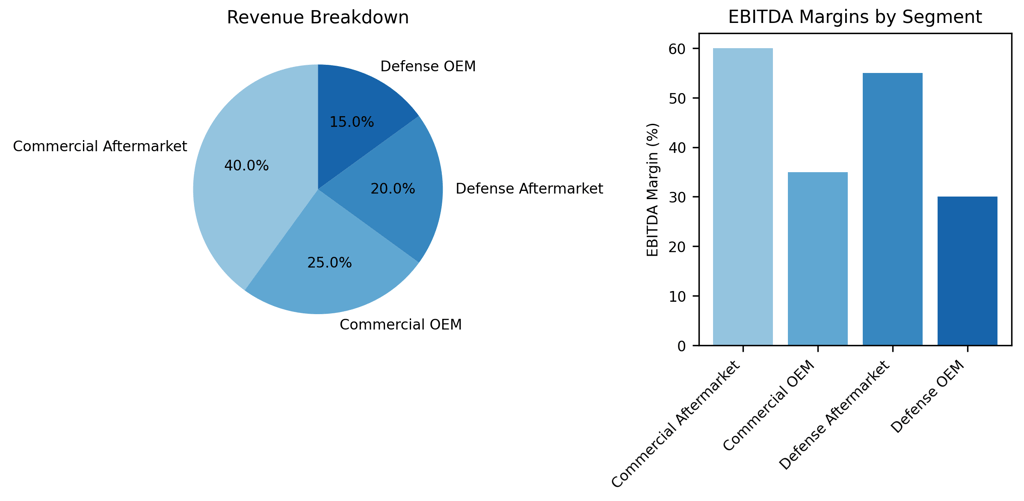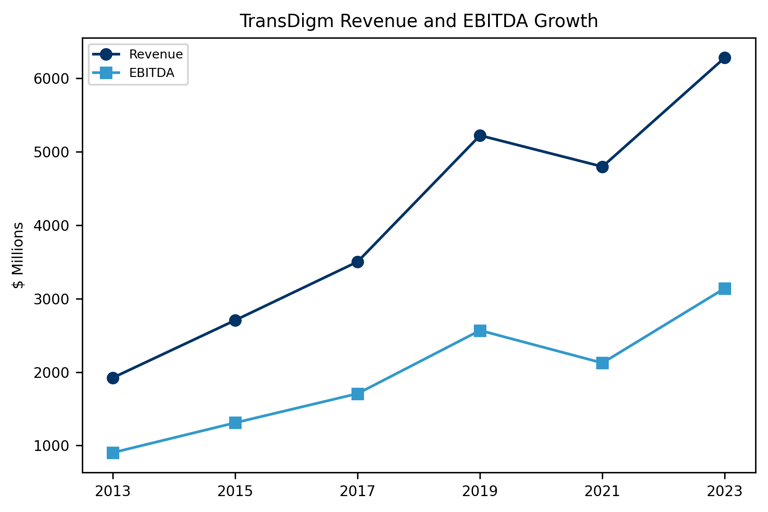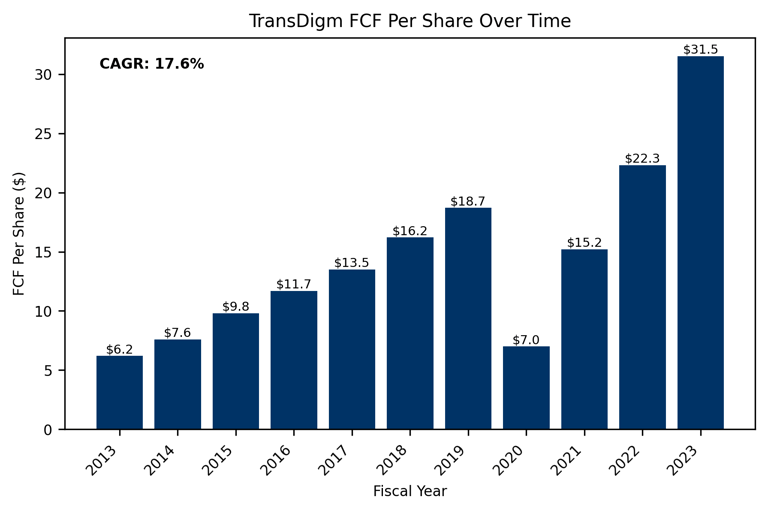Transdigm - Compounding Highflyer
Exploring the niche market dominance and pricing power of TransDigm in the aerospace industry
7/21/20246 min read
1. Company Overview and History
TransDigm Group Incorporated is a leading global designer, producer, and supplier of highly engineered aerospace components, systems, and subsystems. Founded in 1993 and headquartered in Cleveland, Ohio, TransDigm has grown significantly through a combination of strategic acquisitions and organic growth.
The company's products are used on nearly all commercial and military aircraft in service today. TransDigm's business model focuses on acquiring and operating proprietary aerospace businesses with significant aftermarket content, strong customer relationships, and high barriers to entry.
2. Business Model and Revenue Streams
TransDigm's business model is centered around three key elements:
Proprietary Products: The company focuses on products that are sole source or have limited competition, allowing for pricing power. Over 90% of TransDigm's net sales come from products for which they are the sole source or one of two sources.
Aftermarket Focus: A significant portion of revenue comes from the aftermarket, providing stable, recurring revenue streams.
Acquisition Strategy: TransDigm consistently acquires businesses that fit its model, driving growth and expanding its product portfolio.
Revenue Breakdown (FY 2023):
By End Market:
Commercial (65% of revenue):
Commercial Aftermarket: 40%
Commercial OEM: 25%
Defense (35% of revenue):
Defense Aftermarket: 20%
Defense OEM: 15%
By Geography:
United States: 75%
Europe: 15%
Asia-Pacific: 5%
Rest of World: 5%
Notably, approximately 60% of TransDigm's total revenue is derived from aftermarket sales, which are generally considered recurring in nature. This high percentage of recurring revenue provides stability and predictability to the company's financial performance.
Segment Margins (FY 2023):
Commercial Aftermarket: ~60% EBITDA margin
Commercial OEM: ~35% EBITDA margin
Defense Aftermarket: ~55% EBITDA margin
Defense OEM: ~30% EBITDA margin
The higher margins in the aftermarket segments underscore TransDigm's focus on this area of the business.
3. Competitive Landscape and Differentiation
The aerospace components industry is moderately competitive, with several large players like Honeywell, Collins Aerospace (Raytheon Technologies), and Safran competing alongside numerous smaller, specialized manufacturers.
TransDigm differentiates itself through:
Focus on Proprietary Products: Over 90% of TransDigm's net sales come from products for which they are the sole source or one of two sources.
Aftermarket Emphasis: TransDigm's strong focus on the aftermarket (60% of revenues) is higher than many competitors, providing more stable and profitable revenue streams.
Decentralized Structure: Unlike many large aerospace conglomerates, TransDigm maintains a highly decentralized operating structure, allowing for quicker decision-making and closer customer relationships.
Acquisition Expertise: TransDigm has a proven track record of successfully acquiring and integrating businesses, often improving their profitability significantly post-acquisition.
Market Share: While exact market share is difficult to determine due to the fragmented nature of the aerospace components industry, TransDigm is estimated to hold a 5-10% share of the global aerospace components market. More specifically, industry analysts estimate that the company holds approximately 15-20% market share in the commercial aerospace aftermarket for proprietary, engineered components.
4. Financial Performance and Growth Drivers
TransDigm's gross margins are exceptionally high, typically ranging between 55-60%. In fiscal year 2023, the company reported a gross margin of 58.5%. These high margins are primarily attributed to:
Proprietary Products: TransDigm's focus on proprietary, sole-source products allows for significant pricing power.
Aftermarket Dominance: The aftermarket business, which comprises about 60% of revenues, typically carries higher margins than OEM sales.
Operational Efficiency: The company's decentralized structure and focus on cost control contribute to margin strength.
Acquisition Strategy: TransDigm often acquires businesses with potential for margin improvement and successfully implements operational enhancements.
TransDigm has demonstrated strong financial performance over the past decade:
Revenue CAGR (2013-2023): 12.6%
2013 Revenue: $1,924 million
2023 Revenue: $6,283 million
EBITDA CAGR (2013-2023): 13.4%
2013 EBITDA: $904 million (47% margin)
2023 EBITDA: $3,142 million (50% margin)
Free Cash Flow per Share CAGR (2013-2023): 17.7%
2013 FCF per Share: $6.2
2023 FCF per Share: $31.5
Key growth drivers include:
Organic Growth:
Pricing Power: Annual price increases on proprietary products, typically 3-5% per year
New Product Development: R&D spending of about 2-3% of sales annually
Market Share Gains: Leveraging strong customer relationships to win new business
Acquisitive Growth:
Strategic Acquisitions: Regular additions of complementary businesses
Synergy Realization: Cost savings and operational improvements post-acquisition
Market Tailwinds:
Growing Global Air Traffic: 4-5% annual growth pre-pandemic, expected to return to this trend
Increasing Defense Budgets: U.S. defense budget has grown at ~3% CAGR over the past decade
The growth rates of revenue, EBITDA, and Free Cash Flow Per Share show an interesting pattern:
Revenue CAGR (2013-2023): 12.6%
EBITDA CAGR (2013-2023): 13.4%
Free Cash Flow per Share CAGR (2013-2023): 17.7%
EBITDA grows faster than revenue due to:
Margin Expansion: Both organic improvements and acquisition synergies drive EBITDA margin growth.
Operating Leverage: As revenue grows, fixed costs are spread over a larger base, improving EBITDA margins.
Free Cash Flow Per Share grows even faster due to:
Capital Efficiency: TransDigm's business model requires relatively low capital expenditures (typically 2-3% of sales).
Working Capital Management: Efficient management of inventory and receivables.
Tax Optimization: Effective tax planning strategies, including tax benefits from acquisitions.
Share Repurchases: Consistent share buybacks reduce the share count, amplifying per-share metrics.
This cascading effect of growth rates - from revenue to EBITDA to Free Cash Flow Per Share - demonstrates TransDigm's ability to efficiently convert top-line growth into shareholder value, underlining the strength of its business model and management's capital allocation skills.
5. Acquisition Strategy and Performance
Acquisitions have been a key driver of TransDigm's growth. Since its inception in 1993, the company has completed over 80 acquisitions. Key metrics related to their acquisition strategy include:
Average Annual Acquisition Spend: Approximately $1 billion over the past decade.
Post-Acquisition EBITDA Improvement: Typically, TransDigm improves EBITDA margins of acquired businesses by 5-10 percentage points within the first two years post-acquisition.
Acquisition Criteria:
Proprietary, sole-source products
Significant aftermarket content
High margins or potential for margin improvement
Strong and defensible market positions
Recent notable acquisitions include:
Esterline Technologies (2019): $4 billion acquisition, TransDigm's largest to date
Cobham Aero Connectivity (2021): $965 million acquisition
Post-acquisition performance metrics:
Average EBITDA margin improvement: ~8 percentage points within first two years
Revenue synergies: Typically 2-3% additional growth from cross-selling opportunities
6. Management
TransDigm's management team is highly regarded in the industry:
Kevin Stein (CEO since 2018): Joined TransDigm in 2014, previously led several operating units.
Jorge Valladares (COO): With TransDigm since 2008, has held various leadership roles.
Sarah Wynne (CFO): Joined in 2022, bringing extensive aerospace industry experience.
Key Management Characteristics:
Long-term Focus: Incentive structures aligned with long-term value creation
Significant Ownership: Management and directors collectively own about 5% of outstanding shares
Decentralized Approach: Empowers operating unit leaders to make key decisions
7. Business Concentration
TransDigm's business is relatively concentrated:
Customer Concentration: Top 10 customers account for approximately 40% of total sales
Largest customer (Boeing) represents about 10% of sales
No other customer exceeds 5% of sales
Product Concentration: No single product line accounts for more than 5% of total revenue
Platform Concentration:
Commercial Transport: ~45% of sales
Defense: ~35% of sales
Business Jets: ~10% of sales
Other: ~10% of sales
This level of diversification helps mitigate risks associated with any single customer, product, or aircraft platform.
8. Cash Flow Conversion
TransDigm has demonstrated strong cash flow conversion:
EBITDA to Free Cash Flow Conversion: Typically 45-50%
Factors Affecting Cash Flow:
Capital Expenditures: Relatively low, usually 2-3% of sales
Working Capital: Efficient management, with minimal changes year-over-year
Interest Expense: Significant due to high leverage, but manageable given strong EBITDA generation
Taxes: Effective tax planning strategies employed
The company's ability to convert a high percentage of EBITDA to Free Cash Flow has supported its acquisition strategy, debt servicing, and shareholder returns (including special dividends and share repurchases).
9. Future Growth Outlook
TransDigm's future growth potential remains strong, driven by:
Commercial Aerospace Expansion: Expected long-term growth in global air travel, returning to pre-pandemic growth rates of 4-5% annually.
Increasing Defense Budgets: Geopolitical tensions driving higher military spending, with the U.S. defense budget growing at ~3% CAGR.
Emerging Market Opportunities: Growing aerospace markets in Asia and other developing regions.
Technological Advancements: Development of more electric aircraft and advanced materials.
Continued Acquisition Strategy: Ongoing identification and integration of complementary businesses.
Projecting forward, we can estimate:
Revenue CAGR (2024-2028): 8-10%
Free Cash Flow CAGR (2024-2028): 10-12%
These projections are based on:
Continued recovery and growth in commercial aerospace
Stable growth in defense markets
Ongoing successful execution of the acquisition strategy
10. Risks and Mitigations
Cyclicality of Aerospace Industry:
Risk: Exposure to economic cycles affecting air travel and aircraft production.
Mitigation: Diversification across commercial and defense markets; strong aftermarket presence.
Acquisition Risks:
Risk: Overpaying for acquisitions or failure to integrate effectively.
Mitigation: Proven track record of successful acquisitions and integration; disciplined approach to valuation.
Regulatory and Compliance Risks:
Risk: Increased scrutiny of defense contractors and aerospace suppliers.
Mitigation: Strong compliance programs; diversification across multiple programs and customers.
Customer Concentration:
Risk: Reliance on major aircraft manufacturers and airlines.
Mitigation: Diverse product portfolio; strong positions on multiple aircraft platforms.
Debt Levels:
Risk: High leverage could limit financial flexibility.
Mitigation: Strong cash flow generation; history of successful debt management and refinancing.
In conclusion, TransDigm's unique business model, strong market position, and track record of growth make it an attractive investment prospect. The company's focus on proprietary, aftermarket-driven products in the aerospace industry provides a solid foundation for continued success. However, investors should closely monitor the cyclical nature of the aerospace industry and TransDigm's ability to manage its acquisition strategy and debt levels.






